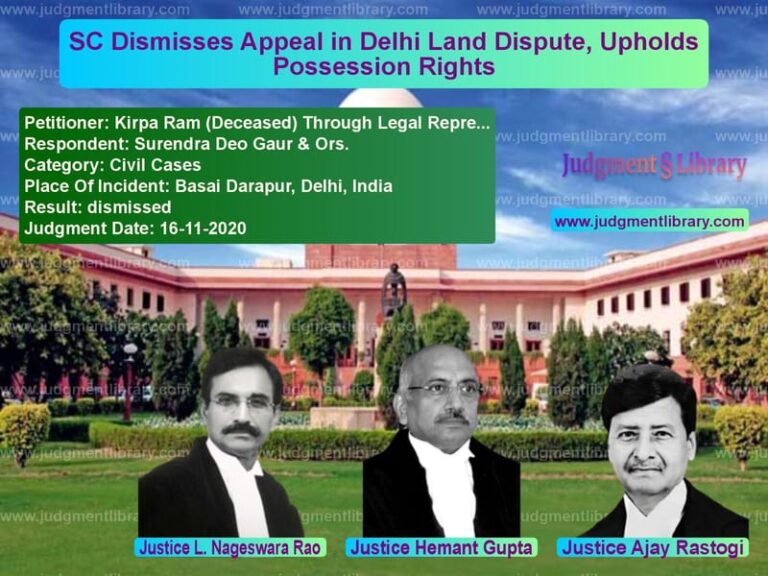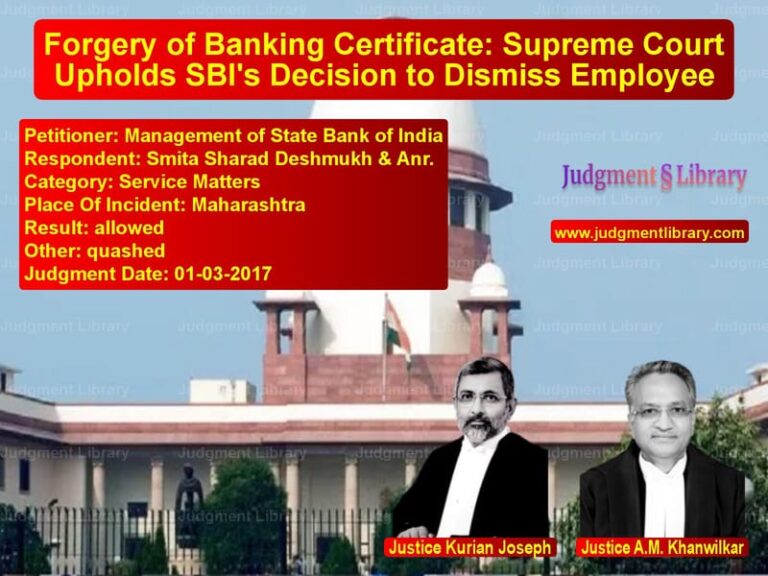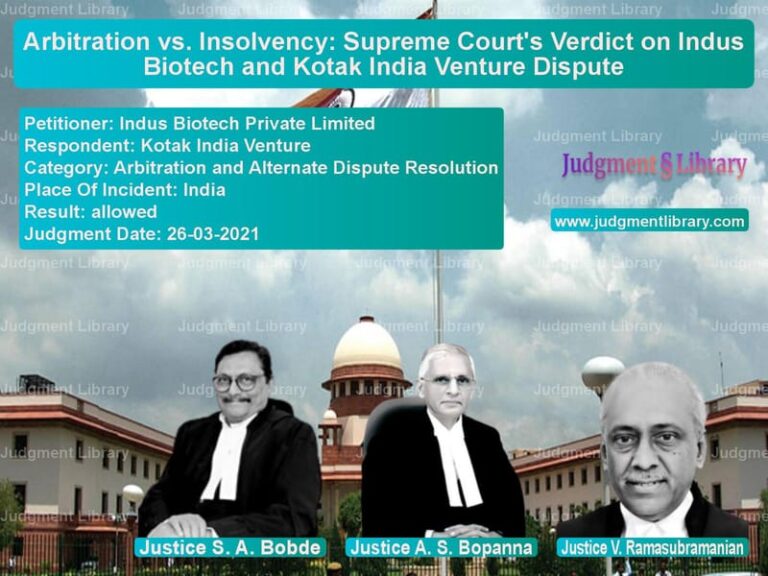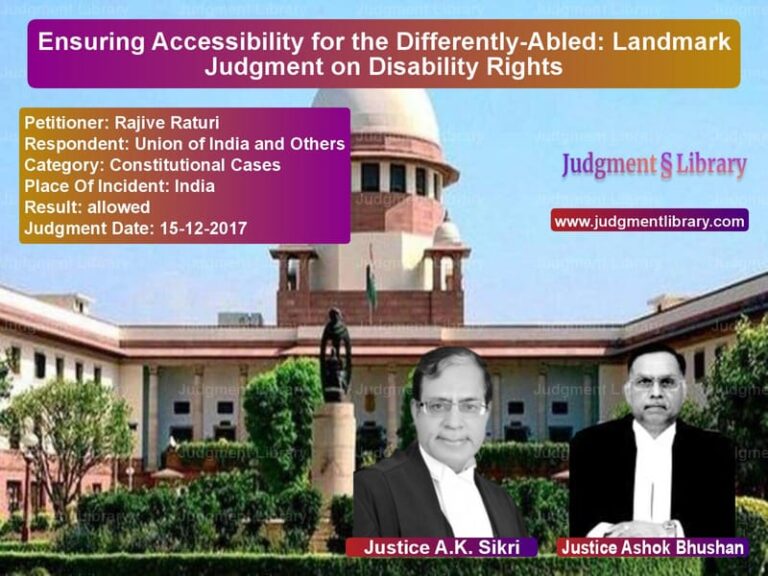Murder Conviction Upheld: Supreme Court Rules on Common Intention in Land Dispute Case
The Supreme Court of India in Asharam Tiwari vs. State of Madhya Pradesh examined the principles of common intention under the Indian Penal Code (IPC) in a case involving a land dispute that led to multiple homicides. The Court upheld the conviction of the appellant under Sections 302/34, 324/34, 325/34, and 323 IPC, affirming the life sentence imposed by the lower courts.
Background of the Case
The case arose from an incident on October 23, 2006, in which the appellant, along with three co-accused, engaged in a violent altercation over a land dispute. The prosecution alleged that the accused attempted to forcefully reclaim land that had been legally purchased by PW-1. Upon the refusal of the complainant, the accused resorted to violence, leading to the deaths of two individuals and injuries to three others.
The trial court convicted the appellant and sentenced him to life imprisonment. The High Court of Madhya Pradesh upheld the decision, leading to an appeal before the Supreme Court.
Key Legal Issues Addressed
1. Whether the Appellant Shared Common Intention with the Other Accused
The primary question was whether the appellant, who was carrying a lathi, shared the common intention of the co-accused who were armed with more lethal weapons (a country-made pistol and an axe). The appellant contended that he did not actively participate in the fatal assaults.
Read also: https://judgmentlibrary.com/kidnapping-and-consent-supreme-court-revisits-sentencing-in-minors-case/
2. Reliability of Eyewitnesses
The defense argued that the prosecution relied on testimony from close family members of the deceased, making their evidence biased. The defense also contended that independent witnesses were not examined.
3. Consideration of Alibi
The appellant argued that his alibi was not given due consideration by the lower courts, and there was insufficient material to establish his presence at the scene.
Findings of the Court
1. Common Intention Was Established
The Supreme Court ruled that the accused acted with a shared common intention. The Court observed:
“Common intention is apparent from the fact that the four accused came armed together to the lands of PW-1. Having failed in their threats to him for return of the lands, all of them assaulted PW-1, PW-4, their daughter, and minor son. The accused then went together to the house of the second deceased and assaulted him also.”
The Court noted that the appellant was aware that the co-accused were carrying lethal weapons, yet he continued to participate in the attack.
2. Eyewitness Testimony Was Trustworthy
The Court upheld the credibility of the prosecution witnesses, stating:
“PW-1 and PW-4 are both injured witnesses. They have been found to be reliable and truthful. We see no reason why they would falsely implicate another when the deceased was their own minor son.”
Regarding the lack of independent witnesses, the Court clarified that it is the quality of evidence that matters, not the number of witnesses.
3. Medical Evidence Corroborated the Assault
The post-mortem reports revealed multiple injuries inflicted with hard and blunt weapons, which matched the use of lathis. This corroborated the role of the appellant in the attack.
4. The Alibi Was Not Substantiated
The Court noted that the appellant failed to provide any concrete evidence in support of his alibi. The defense’s claim that the appellant was falsely implicated at the behest of the village sarpanch was found to be unsubstantiated.
Supreme Court’s Verdict
The Supreme Court dismissed the appeal, holding:
- The appellant was rightly convicted under Sections 302/34, 324/34, 325/34, and 323 IPC.
- Common intention was evident from the coordinated attack.
- Eyewitness testimony was credible and supported by medical evidence.
- The alibi was not proven.
However, considering that the appellant had already served over 14 years in prison and was 72 years old, the Court left it open for the appellant to apply for premature release under applicable legal provisions.
Conclusion
This judgment reaffirms the principles of common intention in criminal law:
- Participation in a coordinated attack can establish common intention, even if the accused did not deliver the fatal blows.
- Eyewitness testimony from family members is admissible if found credible.
- Medical evidence plays a crucial role in corroborating the sequence of events.
- Alibi defenses must be supported by strong evidence.
The ruling upholds the importance of coordinated criminal liability, ensuring that individuals who participate in collective violence are held accountable.
Petitioner Name: Asharam Tiwari.Respondent Name: State of Madhya Pradesh.Judgment By: Justice R.F. Nariman, Justice Navin Sinha.Place Of Incident: Madhya Pradesh.Judgment Date: 12-01-2021.
Don’t miss out on the full details! Download the complete judgment in PDF format below and gain valuable insights instantly!
Download Judgment: asharam-tiwari-vs-state-of-madhya-prad-supreme-court-of-india-judgment-dated-12-01-2021.pdf
Directly Download Judgment: Directly download this Judgment
See all petitions in Murder Cases
See all petitions in Attempt to Murder Cases
See all petitions in Judgment by Rohinton Fali Nariman
See all petitions in Judgment by Navin Sinha
See all petitions in dismissed
See all petitions in supreme court of India judgments January 2021
See all petitions in 2021 judgments
See all posts in Criminal Cases Category
See all allowed petitions in Criminal Cases Category
See all Dismissed petitions in Criminal Cases Category
See all partially allowed petitions in Criminal Cases Category







